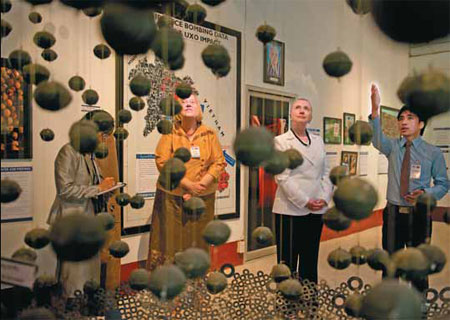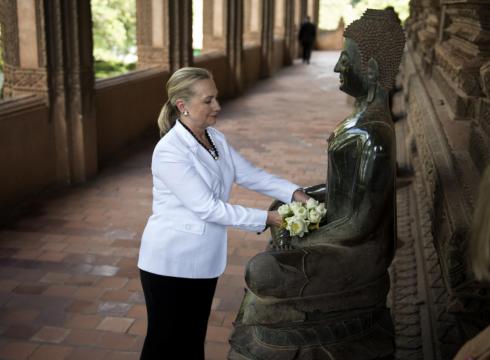July 11– I was just trying to get to work, but at every junction the police officers were telling me to “go that way,” sending me in a circle. Finally I had to break through the barriers by telling them that office was just there in front of us, and there was no other way to get in. The roads around Vientiane College (just blocks away from the Ministry of Foreign Affairs) were closed because Hillary Clinton was in town–the first US Secretary of State to visit Laos in 57 years. (The last was John Foster Dulles in 1955).
The history of US-Lao relations is complicated, and is one that I’ve understood more, and a different angle, since living in this region. During the Vietnam war, the US conducted a “Secret War,”–as the name suggests, largely unknown to the general public–here in Laos to try to head off North Vietnamese troops and to prevent the ascension of Communism in Laos (which happened in 1975, and remains the current government today).

Clinton with Lao prime minister (source: laotimes.com)
One of the places Clinton visited during her short time in Laos (she only spent 4 hours in the country before heading off to meetings elsewhere in the region) was the COPE–Cooperative Orthotic and Prosthetic Enterprise–Center. The COPE Center, just a few blocks from where I live, is a large nonprofit facility that mainly provides physical rehabilitation and care (including providing prosthetics) of disabled people in Laos. Attached to their other facilities is a free welcome center/museum, which I highly recommend visiting if ever in Vientiane. One of the major causes of disability, especially in rural areas (in addition to traffic accidents, which are more common), is UXO, or unexploded ordnance. During the US involvement in Laos in the 1970s, the United States conducted 580,000 bombing missions in Laos, dropping 2 million tons of bombs, making it dismally the “most bombed” country on earth, per capita. As many of the explosives dropped were cluster munitions, which are giant capsules that open and scatter lots of grenade-like bombs, much of the Lao countryside is literally polluted with explosives. These “bombies” remain dangerously unexploded today, and even now, almost 40 years later, are claiming limbs and lives from often totally unaware civilians farming, working, or playing in the countryside.

Clinton touring COPE, in the shadow of bombies (source: chinadaily.com)
Ironically, the United States is one of the only countries that did not sign an international treaty to ban cluster munitions several years ago.
I had been to the COPE center just a few days earlier with my ADS and NZ scholarship students and, even knowing what I did already about the history and repercussions, was struck by the effective presentation and resonance of the COPE mission, and particularly enjoyed the showing of the documentary film “Bomb Harvest,” which follows a team working to disable munitions in Lao provinces.
During her visit, Clinton pledged more support to organizations like COPE and the bomb cleanup efforts, and everyone in Laos, is hoping that’s a promise the US will keep.
My short recap of the Clinton visit is far from comprehensive, if you’re interested in her visit, or US-Lao relations in general, check out:
NY Times article on the Clinton visit
USA Today article on the Clinton visit
Legacies of War
US Ambassador’s blog
Or some of the other links embedded in this post.
